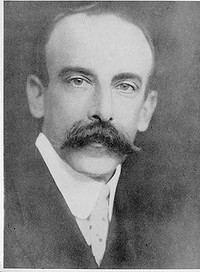E. Phillips Fox facts for kids
Quick facts for kids
E. Phillips Fox
|
|
|---|---|
 |
|
| Born | 12 March 1865 |
| Died | 8 October 1915 (aged 50) Melbourne, Victoria, Australia
|
| Other names | Emanuel Phillips Fox |
| Known for | Painting |
| Spouse(s) | Ethel Carrick (m. 1905) |
Emanuel Phillips Fox (born March 12, 1865 – died October 8, 1915) was an Australian Impressionist painter. Impressionism is a style of painting that uses small, thin brushstrokes. It focuses on showing how light changes and how things look at different times of day.
Fox studied art in Melbourne, Australia. Then he traveled to Paris, France, in 1886 to learn more. He stayed in Europe until 1892. When he came back to Melbourne, he became a leader in the Heidelberg School. This was an important art movement in Australia. He spent many more years painting in Europe before returning to Melbourne, where he passed away.
Contents
Early Life and Art School
Emanuel Phillips Fox was born in Fitzroy, Melbourne. His father, Alexander Fox, was a photographer. Emanuel started studying art at the National Gallery of Victoria Art School in Melbourne. This was from 1878 to 1886.
He learned from a teacher named George Folingsby. Some of his classmates became famous artists too. These included John Longstaff and Frederick McCubbin.
Studying Art in Paris
In 1886, Fox went to Paris, France. He studied at famous art schools there. These included the Académie Julian and the École des Beaux-Arts. His teachers were very well-known artists like William-Adolphe Bouguereau and Jean-Léon Gérôme.
While in Paris, Fox won prizes for his art. He was very interested in en plein air painting. This means painting outdoors to capture light and atmosphere. He showed his paintings at the Paris Salon in 1890. This was a very important art show.
Teaching and Painting in Australia
In 1892, Fox opened the Melbourne School of Art. He taught with Tudor St. George Tucker. They shared new European art ideas and techniques. Fox had a big impact on Australian art during this time.
He was known for paintings that showed people. He also painted quiet landscapes, often at night. These paintings used soft colors. One of his famous works is Art Students (1895). It shows students learning to paint.
Life and Art in Europe
In 1901, Fox received a special job. He was asked to paint a historical picture for the Melbourne gallery. The painting was called The Landing of Captain Cook. He had to paint it while he was overseas. So, Fox moved to London.
He believed it was important to show his art alongside the best artists in Europe. In 1894, he won a gold medal at the Paris Salon. This was for his painting Portrait of my Cousin. He was the first Australian to win this award.
On May 9, 1905, Fox married another artist, Ethel Carrick. They traveled around Italy and Spain. In 1908, they settled in Paris. Fox became a member of important art societies there. He was the first Australian artist to become a full member of the Société Nationale des Beaux-Arts. He also showed his work regularly at the Royal Academy in London.
Coming Back to Australia
In 1913, Fox came back to Australia. He held an exhibition with about seventy of his paintings. People in the local newspapers were very excited about his show. They wrote about how he captured light and atmosphere in his art. They said he found "infinite beauty" in everyday things. The Arbour is a lovely example of his work from this time.
One of his most important paintings was The Landing of Captain Cook at Botany Bay. He also made a copy of a famous painting of Captain Cook.
Death
Emanuel Phillips Fox passed away from cancer on October 8, 1915. He was 50 years old. He died in a hospital in Fitzroy, Melbourne. His wife, Ethel, lived for many more years after him. They did not have any children.
Images for kids
See also
- Nasturtiums (E. Phillips Fox)












